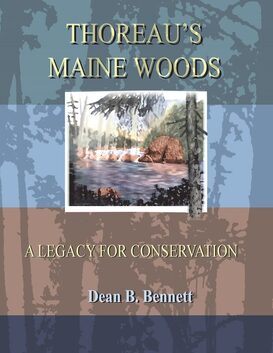Thoreau's Maine Woods
A Legacy for Conservation
by Dean B. Bennett
A Legacy for Conservation
by Dean B. Bennett
|
Dean B. Bennett began painting and photographing the north woods in his home state of Maine in the late 1950s and early 1960s when he began canoeing the Upper West Branch of the Penobscot River and the Allagash Wilderness Waterway and backpacking in Baxter State Park. Since then, while pursuing a varied career, he has retraced much of each route Thoreau traveled in the Maine woods. After completing a four-year apprenticeship in cabinetmaking through the Maine State Apprenticeship Council, he went on to receive a bachelor’s degree in industrial arts education and a master’s degree in science education, teaching both subjects in the Yarmouth, Maine, school system. Later he received a Ph.D. in Resource Planning and Conservation from the University of Michigan with a special emphasis in environmental education. Since then, much of his professional life has been devoted to teaching, writing, and illustrating books in the fields of science and environmental education, natural history, and human relationships with nature. He served as the first environmental education school curriculum specialist in the Maine State Department of Education, and later, he spent many years at the University of Maine at Farmington as a professor of science education. He was among one-hundred educators selected by Unesco to participate in the first world environmental education conference in Belgrade Yugoslavia, and at the organization’s invitation, he wrote a book on evaluating environmental learning for teachers. He received the Percival Baxter Award for Leadership in Wilderness Preservation from the Maine Chapter of the Sierra Club, the Environmental Activist Award for protection of the Allagash Wilderness Waterway from the Natural Resources Council of Maine, and the Teacher of the Year Award from Maine Audubon Society. In 2014, he and his wife Sheila K. Bennett jointly received from the Conservation Voters of Maine the Harrison L. Richardson Environmental Leadership Award for ‘… inspiring all of us to care for the nature of Maine and its wild places.’” This is his eleventh book in the nature/environment field. His other books include: Maine’s Natural Heritage: Rare Species and Unique Natural Features, Allagash: Maine’s Wild and Scenic River, The Forgotten Nature of New England: A Search for Traces of the Original Wilderness, The Wilderness from Chamberlain Farm: A Story of Hope for the American Wild, On Wilderness: Voices from Maine (in collaboration with Phyllis Austin and Robert Kimber), Nature and Renewal: Wild River Valley and Beyond, Ghost Buck: The Legacy of One Man’s Family and its Hunting Traditions (a memoir), and three children’s books, which he illustrated in watercolor. He enjoys playing jazz and ragtime music on his plectrum banjo and continues to hike and canoe with his wife in the north woods of Maine.
|
What cannot be underestimated is Henry David Thoreau's role in the conservation of the Maine woods and in conservation thought in general. Both went far beyond his life and the confines of his native Concord. Writing in the mid-1800s, he was one of the first to describe the wild nature of these woods in terms of their emotional and ethical relationships within a conservation context. It is not entirely by chance that a considerable amount of land surrounding the roughly 200 miles that his three trips covered through the wildest part of the Maine woods has ended up with some kind of conservation protection. Thoreau brought attention to these woods through his book, The Maine Woods, published in 1864, and that attention found its way into the minds of many of those who spearheaded efforts to save some measure of their wildness.
|

